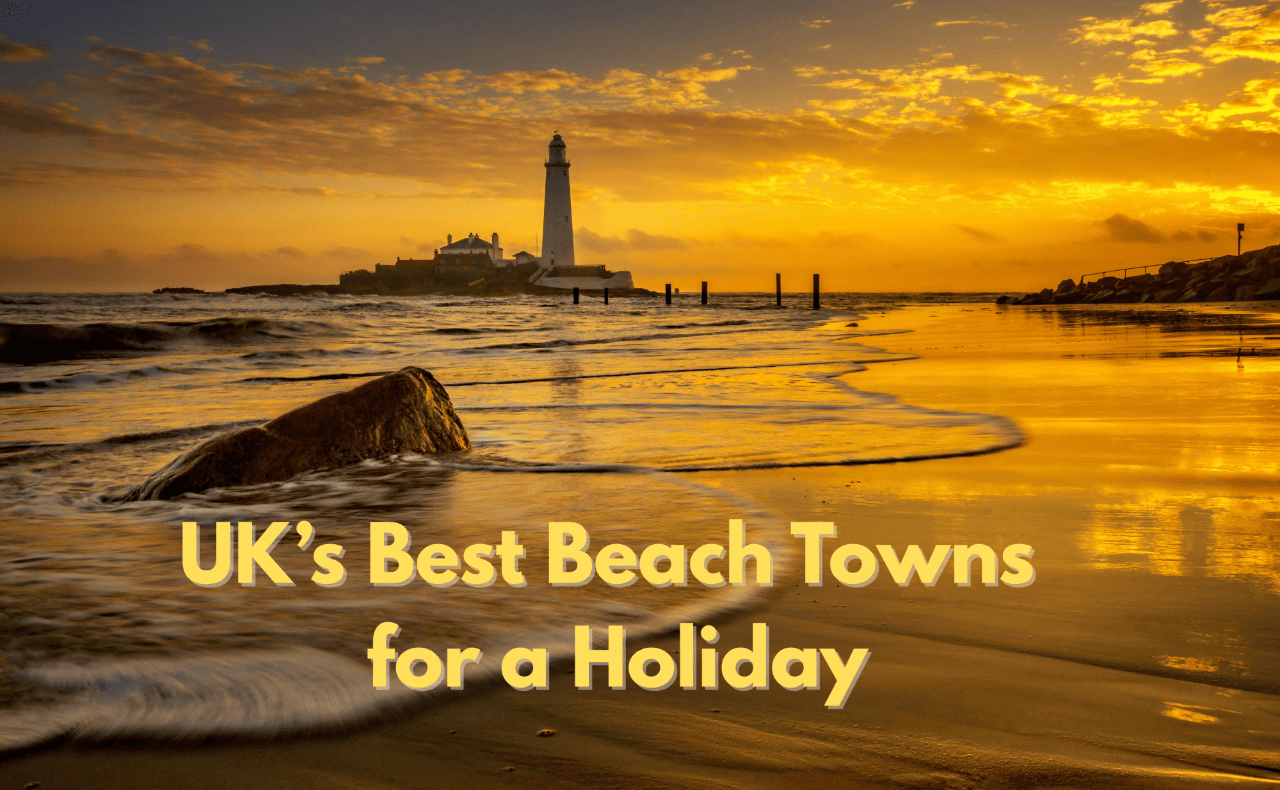Discover the perfect seaside escape along Britain’s stunning coastline

There’s something magical about the British coastline that keeps drawing me back year after year. Whether it’s the crash of waves against dramatic cliffs, the feel of sand between my toes, or simply the joy of proper fish and chips with a sea view, UK coastal getaways, especially the Best Beach Towns, offer something for every traveler. I’ve spent countless weekends exploring hidden coves, charming seaside towns, and spectacular beaches that rival any international destination. The Best Beach Towns in the UK are truly unforgettable.
Exploring the Best Beach Towns in the UK
For anyone seeking relaxation and adventure, the Best Beach Towns in the UK stand out as perfect destinations.
If you’re planning your next holiday and craving that perfect mix of relaxation, adventure, and quintessential British charm, you’re in the right place. I’ve compiled this guide to the absolute best Beach Towns in the UK, complete with insider tips on when to visit, where to stay, and what not to miss at each destination.
From the art-filled streets of St Ives to the dramatic castle views of Bamburgh, these Best Beach Towns will have you falling in love with Britain’s shorelines all over again. The vibrant culture and stunning scenery of the Best Beach Towns make them ideal for holidaymakers.
1. St Ives, Cornwall
The Best Beach Towns also offer delicious local cuisine, ensuring a delightful experience.

Each of these Best Beach Towns boasts unique features that make them worth visiting.
Many of the Best Beach Towns have rich histories that add to their charm.
Visiting the Best Beach Towns during the off-peak season can enhance your experience.
St Ives is one of the Best Beach Towns that captures the imagination with its beauty.
Don’t forget to explore the local attractions in these Best Beach Towns!
Bamburgh is another one of the Best Beach Towns that offers stunning views and activities.
Exploring the Best Beach Towns guarantees unforgettable adventures and picturesque views.
Plan your next trip to one of the Best Beach Towns for an enriching coastal experience.
There’s a reason St Ives consistently tops lists of the best UK coastal getaways. This picture-perfect Cornish town feels like it was plucked straight from a postcard, with its golden sandy beaches, crystal-clear waters, and charming cobbled streets.
What makes St Ives truly special is its unique blend of natural beauty and cultural richness. The quality of light here has attracted artists for generations, resulting in a thriving creative scene. You can spend your morning soaking up the sun on Porthmeor Beach, then wander through the Tate St Ives or the many independent galleries showcasing local talent.
Whitby is among the Best Beach Towns that blend historical significance with natural beauty.
When hunger strikes, you’re spoiled for choice with fresh seafood restaurants and cozy cafés serving Cornish cream teas. I particularly recommend grabbing a pasty from a local bakery and enjoying it on the harbor wall while watching the fishing boats come in.
Don’t miss the chance to visit more of the Best Beach Towns in your travels!
Best time to visit: May through September offers the warmest weather, but I’m a big fan of visiting in June before the summer holiday crowds arrive.
Don’t miss: A day trip to nearby Seal Island to spot Atlantic grey seals in their natural habitat.
Whether you want a lively atmosphere or a quiet retreat, the Best Beach Towns cater to all preferences.
2. Bamburgh, Northumberland
Newquay exemplifies the energy found in many of the Best Beach Towns across the UK.
Families will find that Newquay, one of the Best Beach Towns, offers a variety of activities.
The Best Beach Towns like Newquay provide a blend of excitement and relaxation.
If you’re after dramatic scenery that combines history with natural beauty, Bamburgh should be at the top of your list. Dominated by its magnificent castle perched on a dolerite outcrop, Bamburgh offers one of the most striking coastal landscapes in Britain.
The beach here is simply spectacular—a vast stretch of golden sand that rarely feels crowded, even in peak season. On clear days, you can see all the way to the Farne Islands, a renowned bird sanctuary and home to a significant puffin colony.
Southwold represents the charm found in the Best Beach Towns of England.
What I love most about Bamburgh is how it feels both grand and intimate at the same time. You can walk in the shadow of the imposing castle, then find your own private spot among the dunes for a peaceful afternoon with nothing but the sound of waves for company.
Best time to visit: Spring brings wildflowers to the dunes, while autumn offers dramatic skies perfect for photography.
Don’t miss: The Grace Darling Museum, which tells the story of a famous Victorian heroine who participated in a daring sea rescue.
3. Whitby, North Yorkshire
With its Gothic abbey ruins standing sentinel on the East Cliff, Whitby is perhaps one of the most atmospheric coastal towns in Britain. Its connection to Bram Stoker’s Dracula adds a layer of intrigue that complements its natural beauty and maritime heritage.
The Best Beach Towns like Anglesey impress with their varied landscapes.
The town strikes a perfect balance between traditional seaside charm and cultural significance. You can climb the 199 steps to the abbey for breathtaking views, hunt for Whitby jet (a black gemstone) on the beaches, or indulge in what many consider the best fish and chips in the country.
Whitby’s harbor buzzes with activity, from fishing boats bringing in the day’s catch to pleasure cruises heading out along the Heritage Coast. The beach is family-friendly with safe swimming areas and plenty of rock pools to explore at low tide.
Best time to visit: October for the Whitby Goth Weekend if you’re after something different, or summer for traditional seaside fun.
Don’t miss: A whale-watching trip—the Yorkshire coast is one of the best places in the UK to spot minke whales and dolphins.
Best Beach Towns: 4. Newquay, Cornwall
Brighton showcases the lively spirit characteristic of the Best Beach Towns.
As Britain’s undisputed surfing capital, Newquay offers a more energetic coastal experience than some of our other destinations. Fistral Beach draws surf enthusiasts from around the world with its consistent waves, while the town itself has evolved into a hub for beach culture and nightlife.
But don’t let Newquay’s reputation as a surf town fool you—it’s also perfect for families and those seeking relaxation. The town boasts eleven beaches, ranging from the bustling Towan Beach in the center to secluded coves like Lusty Glaze, which is sheltered by cliffs on all sides.
I’ve found that one of Newquay’s greatest charms is how easy it is to switch between vibrant energy and peaceful tranquility. You can start your day with a surfing lesson, spend the afternoon exploring rock pools with the kids, and end with a sunset dinner at one of the excellent restaurants overlooking the Atlantic.
Best time to visit: September offers warm water for swimming but fewer crowds than the peak summer months.
Don’t miss: The annual Boardmasters Festival if you’re visiting in August—it combines surf competitions with live music.
Llandudno offers a classic coastal experience among the Best Beach Towns in Wales.
5. Southwold, Suffolk
Southwold represents the quintessential English seaside town—refined, charming, and pleasantly nostalgic. Its row of candy-colored beach huts has become iconic, while the lighthouse standing tall amidst residential streets creates a distinctive silhouette.
What sets Southwold apart is its unspoiled character. The town has successfully resisted overdevelopment, maintaining its traditional appeal with independent shops, the Adnams Brewery, and the wonderfully eccentric Under the Pier Show—a collection of quirky handmade arcade machines.
The beach here is predominantly pebbly but gives way to sand at low tide. It’s perfect for long walks, especially if you extend your stroll to take in the harbor where local fishermen sell their catch directly from their boats.
Best time to visit: Early summer when the days are long but before the school holiday rush.
Don’t miss: A tour of the Adnams Brewery followed by a tasting session of their excellent beers and spirits.
Planning your trip to the Best Beach Towns can lead to wonderful adventures.
6. Anglesey, Wales
Anglesey might not always get the attention it deserves, but this island off the northwest coast of Wales offers some of the UK’s most stunning beaches. With 17 beaches to choose from, including the expansive sands of Rhosneigr and the picturesque bay at Trearddur, you’re spoiled for choice.
What I particularly love about Anglesey is its diverse coastal landscape. In a single day, you can explore rocky coves, walk along golden beaches, and take in dramatic cliffs. The island is also home to a significant portion of the Wales Coast Path, offering spectacular walking opportunities.
The local seafood is exceptional, with restaurants serving freshly caught fish and the famous Menai mussels. And if you’re interested in history, Anglesey doesn’t disappoint, with ancient sites including standing stones and the fascinating tidal island of Llanddwyn.
Best time to visit: May or September when the weather is still pleasant but the beaches are quieter.
Don’t miss: South Stack Lighthouse and its breathtaking clifftop location, where you might spot puffins nesting in season.
7. Brighton, East Sussex
For those seeking a coastal getaway with a hefty dose of culture and nightlife, Brighton delivers in spades. This vibrant city combines traditional seaside pleasures—the iconic pier, pebble beach, and fish and chip shops—with a progressive, artistic spirit that makes it unique among UK coastal destinations.
Filey is an underrated gem among the Best Beach Towns.
Brighton’s beach may be pebbly rather than sandy, but that doesn’t deter visitors who come for the lively atmosphere and excellent facilities. The restored Victorian pier provides classic amusements, while the ruins of the West Pier offshore create an atmospheric backdrop for photographers, especially at sunset.
Beyond the beach, the narrow lanes of the old town are filled with independent shops, cafés, and restaurants catering to all tastes. The Royal Pavilion, with its distinctive Indian-inspired architecture, offers a glimpse into the city’s regal past.
Best time to visit: Brighton is a year-round destination, but May brings the Brighton Festival and perfect temperatures for enjoying the beach.
Don’t miss: A ride on the British Airways i360, a moving observation tower providing panoramic views across the Channel and South Downs.
8. Llandudno, Wales
Llandudno is the queen of Welsh resorts, a title it’s held since Victorian times when its elegant promenade and grand hotels first welcomed visitors seeking seaside air. This classical seaside town has maintained its period charm while adding modern comforts.
The town sits on a curved bay between two headlands—the Great Orme and Little Orme—creating a sheltered sweep of beach that’s perfect for families. The immaculately preserved pier stretches out into the Irish Sea, offering traditional entertainments and spectacular views back to the town and surrounding hills.
I’m particularly fond of the Great Orme, a limestone headland that can be ascended by vintage tramway or cable car. The summit rewards visitors with panoramic views across North Wales and, on clear days, as far as the Isle of Man and the Lake District.
Best time to visit: Spring brings wildflowers to the Great Orme and pleasant temperatures for exploring.
Don’t miss: A ride on the Great Orme Tramway, Britain’s only cable-hauled street tramway that’s been operating since 1902.
FAQs About UK Coastal Getaways
What are the best coastal destinations in the UK for a holiday?
The UK offers incredible diversity when it comes to coastal destinations. For artistic charm and beautiful beaches, St Ives in Cornwall is hard to beat. For dramatic scenery with historical significance, Bamburgh in Northumberland offers a stunning castle backdrop. Surfing enthusiasts should head to Newquay, while those seeking a traditional seaside experience will love Southwold or Llandudno. Each coastal region has its own character—the Southwest is known for milder weather and holiday atmosphere, while the Northeast offers more rugged, dramatic landscapes.
Which UK beaches are family-friendly?
Filey in North Yorkshire offers a wide, safe sandy beach that’s perfect for families with young children. Bournemouth Beach in Dorset combines golden sand with plenty of facilities and entertainment. Tenby in Wales has sheltered beaches surrounded by the town walls. For rock pooling adventures, both Whitby and St Ives offer excellent options at low tide. Most popular UK beach destinations provide lifeguard services during summer months, but always check local information before swimming.
What is the best time of year to visit UK seaside towns?
The peak season runs from June through August when schools are on holiday, offering the warmest weather but also the largest crowds. For a more peaceful experience with pleasant temperatures, consider May, early June, or September. Many coastal towns have their own unique calendar of events—Whitby hosts its famous Goth Weekend in April and October, while Newquay’s Boardmasters Festival happens in August. Winter visits can be atmospheric and romantic, with storm-watching becoming increasingly popular along the dramatic coastlines of Cornwall and Scotland.
![Insert image of a UK beach during different seasons here]
Are there dog-friendly beaches in the UK?
Yes, many UK beaches welcome four-legged visitors, though restrictions often apply during peak summer seasons. Holkham Beach in Norfolk offers miles of sand where dogs can run freely year-round. Trearddur Bay on Anglesey is dog-friendly with some seasonal restrictions. In Northumberland, large sections of Bamburgh Beach permit dogs throughout the year. Always check local signage as regulations can change, and some beaches have designated dog-friendly sections while restricting access to other areas.
What are the top activities to do at UK coastal locations?
Beyond sunbathing and swimming, UK coastal locations offer diverse activities:
- Surfing and paddleboarding are popular in Cornwall and Wales
- Fossil hunting along the Jurassic Coast in Dorset
- Coastal walking on designated paths like the South West Coast Path
- Bird and wildlife watching, especially in places like the Farne Islands
- Exploring maritime history in towns like Whitby and Portsmouth
- Local food experiences, particularly seafood fresh from local boats
- Visiting coastal castles and historical sites, from Bamburgh to Tintagel
The right activities depend on your location—each coastal region specializes in different experiences based on its natural features and heritage.
9. Scarborough, North Yorkshire
As Britain’s first seaside resort, Scarborough has been perfecting the art of the beach holiday for over 360 years. Split across two bays (North and South), the town offers a classic seaside experience with modern amenities that make it particularly suitable for families.
South Bay is the more developed of the two, with amusement arcades, ice cream parlors, and the harbor. The recently renovated Scarborough Spa complex hosts concerts and events throughout the year. North Bay, meanwhile, offers a more tranquil experience with its colorful beach huts and the opportunity to spot seabirds along the Cleveland Way.
One of Scarborough’s unique features is Peasholm Park, an Oriental-themed garden complete with a lake where mock naval battles have been staged since 1927 using model ships. It’s these touches of eccentric charm that give the town its special character.
Best time to visit: July and August for the full seaside experience, but September offers warm sea temperatures with fewer crowds.
Don’t miss: A visit to the impressive ruins of Scarborough Castle, which offers spectacular views across both bays.
10. Jurassic Coast, Dorset
The Jurassic Coast isn’t just a beach destination—it’s a journey through 185 million years of Earth’s history. This UNESCO World Heritage Site stretches for 95 miles along the southern coast of England, with some of its most iconic spots located in Dorset.
Durdle Door, a natural limestone arch standing in the sea, has become one of Britain’s most photographed landmarks. Nearby Lulworth Cove, with its almost perfectly circular bay, demonstrates the power of erosion in creating stunning natural features. Both are connected by a relatively easy cliff-top walk that offers breathtaking views.
For fossil hunters, Charmouth and Lyme Regis are the places to go. After winter storms or high tides, the chances of finding ammonites and even ichthyosaur remains are surprisingly good. The Charmouth Heritage Coast Centre offers guidance on what to look for and how to fossil hunt responsibly.
Best time to visit: Spring offers wildflowers along the cliff paths, while autumn brings dramatic skies perfect for photography.
Don’t miss: A boat trip from Lyme Regis or Weymouth to view the spectacular coastline from the water.
11. Portmeirion, Wales
Technically not an island but a peninsula, Portmeirion offers one of the UK’s most unusual coastal experiences. This fantasy village, designed by Sir Clough Williams-Ellis between 1925 and 1975, was built to show how a naturally beautiful landscape could be developed without spoiling it.
The result is an extraordinary Italian-style village nestled on the edge of Snowdonia, with colorful buildings, exotic gardens, and woodland walks leading down to a stunning estuary beach. When the tide is out, you can walk across vast stretches of sand, while the surrounding hills provide protection from harsh weather.
Portmeirion is best known as the filming location for the cult 1960s TV series “The Prisoner,” and it maintains that slightly surreal quality today. It feels like a Mediterranean village somehow transported to the Welsh coast.
Best time to visit: May or September when you can enjoy the gardens in bloom but avoid the summer crowds.
The Isle of Wight hosts a range of experiences as one of the Best Beach Towns.
Don’t miss: The annual Festival No.6, a boutique music and arts festival held in September that takes full advantage of this unique setting.
12. Isle of Skye, Scotland
For those willing to venture further north, the Isle of Skye offers coastal scenery on an epic scale. Connected to the Scottish mainland by a bridge, this island combines dramatic mountains, crystal-clear pools, and secluded beaches that often feel untouched by human presence.
Staffin Bay on the northeastern coast features dinosaur footprints preserved in the rock, while the Fairy Pools in the island’s interior provide magical swimming spots (though the water is decidedly bracing even in summer). The coastline is deeply indented with sea lochs, creating countless vantage points for spectacular sunsets.
Trearddur Bay highlights the stunning scenery found in the Best Beach Towns of Anglesey.
What makes Skye particularly special is how the coastal experience intertwines with Gaelic culture and history. You can visit ancient clan strongholds like Dunvegan Castle, then warm up in a traditional pub where impromptu music sessions might break out on any night of the week.
Best time to visit: May and early June offer the best chance of good weather and fewer midges.
Don’t miss: The Neist Point Lighthouse at sunset—one of the most photographed locations in Scotland for good reason.
13. Filey, North Yorkshire
Often overshadowed by its more famous neighbors Scarborough and Whitby, Filey offers a quieter, more laid-back coastal experience that’s particularly perfect for families. The town has retained its fishing village charm while developing just enough amenities to make for a comfortable holiday.
The beach is Filey’s crown jewel—a five-mile stretch of clean golden sand that never feels overcrowded, even in peak season. At low tide, the beach expands dramatically, creating vast play spaces for children and long walking opportunities for adults.
When visiting the Best Beach Towns, enjoy the local attractions and natural beauty.
Filey Brigg, a narrow peninsula extending into the North Sea, offers excellent rock pooling and bird watching. The town itself has a genteel atmosphere with independent shops and tearooms rather than amusement arcades, making it ideal for those seeking relaxation.
Best time to visit: July and August for the best beach weather, though Filey is charming year-round.
Don’t miss: A walk along the Brigg at low tide to explore the rock pools and spot seabirds.
14. Isle of Wight
Just a short ferry ride from the mainland, the Isle of Wight packs remarkable variety into a small area. The island offers everything from traditional seaside resorts like Sandown and Shanklin to wild, unspoiled beaches and dramatic chalk cliffs reminiscent of Dover.
Sandown Beach exemplifies the classic British seaside experience with its pier, esplanade, and family-friendly amenities. For something more natural, Compton Bay offers fossil hunting and one of the best surfing spots on the island.
What I particularly appreciate about the Isle of Wight is its accessibility—you can easily travel around the entire island in a day, sampling different coastal experiences as you go. The island also boasts an impressive microclimate, often enjoying more sunshine hours than much of mainland Britain.
Best time to visit: June offers pleasant temperatures before the summer rush, while early September still provides warm swimming conditions.
Don’t miss: The Needles, a row of three distinctive chalk stacks rising from the sea, best viewed from the headland or by boat tour.
15. Tenby, Wales
Colwyn Bay epitomizes the transformation of the Best Beach Towns.
Cromer specializes in inviting visitors to explore its beaches, making it one of the Best Beach Towns.
With its pastel-colored houses clustered around a picturesque harbor, Tenby is perhaps the most photogenic of Wales’ coastal towns. Medieval town walls surround the old center, while no less than three beautiful beaches lie within walking distance.
North Beach, with its views of Tenby harbor and cliff-backed setting, has earned Blue Flag status for its cleanliness and facilities. Castle Beach becomes dramatically different as the tide changes, revealing rock pools and caves to explore. South Beach stretches for nearly a mile and a half, providing plenty of space even during busy summer days.
The town itself is a maze of narrow streets filled with independent shops, galleries, and excellent restaurants specializing in local seafood. Boats run regularly from the harbor to nearby Caldey Island, home to Cistercian monks and some of the most tranquil beaches in Wales.
Best time to visit: September, when the sea is still warm but the summer crowds have departed.
Don’t miss: A trip to Caldey Island to sample the chocolate and perfume made by the monks.
16. Bournemouth Beach, Dorset
Consistently voted among the UK’s best beaches, Bournemouth offers seven miles of golden sand backed by a vibrant cosmopolitan town. The beach has been meticulously maintained since Victorian times and benefits from a microclimate that makes it several degrees warmer than many other UK coastal destinations.
The pier remains the focal point of the seafront, offering entertainment and spectacular views along the coast to the Isle of Wight and the Purbeck Hills. Beach huts in candy colors line the promenade, with some available for daily hire—the perfect base for a day of sun, sea, and sand.
Bournemouth has successfully evolved beyond the traditional seaside resort model to become a year-round destination with excellent shopping, dining, and nightlife options. The town’s gardens run from the beach right into the center, creating a green corridor that’s rare in seaside towns.
Best time to visit: June offers warm weather and relatively quiet beaches before the school holiday rush.
Don’t miss: The Bournemouth Air Festival in late August/early September, when aircraft displays take place over the seafront.
Durdle Door is a highlight among the Best Beach Towns for its natural beauty.
17. Colwyn Bay, Wales
Following significant regeneration in recent years, Colwyn Bay has been transformed into one of North Wales’ most appealing coastal destinations. The beach has been widened and improved with imported sand, while the promenade has been completely redesigned to create a modern seafront experience.
The bay’s three miles of sandy beach provide ample space for relaxation and play, while the Porth Eirias complex offers water sports equipment hire and lessons for those feeling more adventurous. It’s also home to a restaurant by celebrity chef Bryn Williams, making it one of the few UK beaches where you can enjoy genuinely fine dining with a sea view.
One of Colwyn Bay’s greatest advantages is its proximity to other attractions. The Welsh Mountain Zoo sits on the hillside above the town, offering a perfect alternative activity on cooler days, while the Victorian resort of Llandudno is just a short drive away.
Best time to visit: May through September offers the best conditions for enjoying the beach.
Don’t miss: A visit to the neighboring town of Rhos-on-Sea, where you can find St Trillo’s Chapel—possibly the smallest church in Britain, built right on the shoreline.
18. Cromer, Norfolk
Cromer embodies the gentle charm of the Norfolk coast, with its Victorian pier stretching into the North Sea and streets filled with independent shops rather than chain stores. The town is famous for its sweet, succulent crabs, caught daily by the local fishing fleet that still launches from the beach.
The beach itself is a mix of sand and shingle that becomes predominantly sandy at low tide. The pier houses the Pavilion Theatre, one of the last places in Britain still offering traditional end-of-pier variety shows throughout the season.
What makes Cromer particularly special is its connection to local traditions and history. The RNLI Henry Blogg Museum celebrates the town’s most decorated lifeboat man, while the annual Cromer Carnival in August maintains traditions that stretch back decades.
Best time to visit: August for the carnival atmosphere, or June for quieter enjoyment of the town and beaches.
Don’t miss: A Cromer crab sandwich from one of the town’s cafés—the sweet, delicate meat has made these crustaceans famous throughout Britain.
19. Trearddur Bay, Anglesey
On Anglesey’s western coast, Trearddur Bay combines a spectacular natural setting with excellent facilities for water sports enthusiasts. The bay’s blue waters and golden sand are framed by rocky headlands that provide shelter and create perfect conditions for sailing, kayaking, and paddleboarding.
The main beach has achieved Blue Flag status for its cleanliness and safety, making it ideal for families. What I particularly love about Trearddur Bay is how quickly you can escape the main beach area and find yourself on peaceful coastal paths with breathtaking views across the Irish Sea.
The village itself has developed tastefully to support tourism without overwhelming the natural beauty that makes it special. You’ll find a selection of restaurants and accommodation options, but the atmosphere remains relaxed and unspoiled.
Best time to visit: June offers the perfect balance of good weather and quieter beaches.
Don’t miss: A sunset walk around the headland to Porth Diana, a small sheltered cove that’s often overlooked by day visitors.
20. Durdle Door, Dorset
I’ve already mentioned the Jurassic Coast as a destination, but Durdle Door deserves its own entry as one of Britain’s most iconic coastal landmarks. This natural limestone arch has been shaped by erosion over thousands of years and now stands as a gateway to the perfect crescent beach below.
Reaching the beach involves a steep path down from the cliff top, which helps limit visitor numbers and preserves the pristine quality of the location. The effort is well rewarded with crystal-clear waters perfect for swimming (though there are no lifeguards) and a sense of being surrounded by natural beauty.
What makes Durdle Door particularly special is how it changes with the light throughout the day. Early morning brings soft light perfect for photography, while sunset can turn the arch into a dramatic silhouette. On clear nights, the lack of light pollution makes this an excellent spot for stargazing.
Best time to visit: May or September avoid the summer crowds while still offering good chances of favorable weather.
Don’t miss: The walk over the hill to neighboring Lulworth Cove, a perfectly formed natural harbor that offers a complete contrast to Durdle Door’s open beach.
Conclusion: Explore the Best Beach Towns
The UK coastline offers an astonishing variety of experiences, from the artistic enclaves of Cornwall to the dramatic landscapes of Scotland. Whether you’re seeking family fun, romantic seclusion, or active adventure, there’s a perfect coastal getaway waiting for you.
What makes these destinations truly special isn’t just their natural beauty—it’s the distinctive character each has developed over centuries of connection with the sea. From fishing heritage to Victorian elegance, every coastal town tells its own story through its architecture, food, and traditions.
I hope this guide has inspired you to explore more of Britain’s magnificent shoreline. With over 11,000 miles of coast to discover, these twenty destinations are just the beginning of what could be a lifetime of coastal adventures. Which will you visit first?
Planning Your UK Coastal Getaway
Before you pack your bucket and spade, consider these final tips:
- Book accommodation well in advance for summer visits to popular destinations
- Check tide times when visiting beaches known for dramatic tidal ranges
- Pack for changeable weather—even in summer, British coastal areas can experience all four seasons in one day
- Consider visiting outside peak season for a more authentic experience and better value
- Look into heritage passes if you plan to visit multiple historic sites along the coast
Remember that some of the best coastal experiences come from unexpected discoveries—the tiny café serving fresh seafood, the hidden cove reached by a cliff path, or the local festival that brings a town to life. Keep an open mind, talk to locals, and you’ll find your own perfect slice of the British coast.







Thank you for your sharing. I am worried that I lack creative ideas. It is your article that makes me full of hope. Thank you. But, I have a question, can you help me?